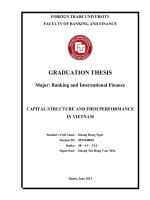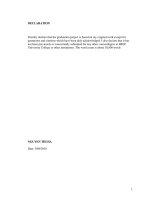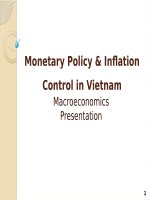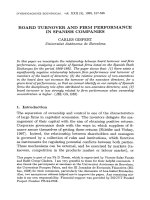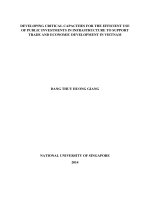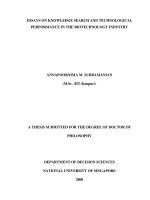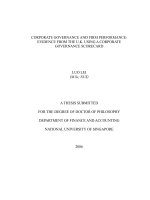Ownership structure, board characteristics and firm performance in vietnam
Bạn đang xem bản rút gọn của tài liệu. Xem và tải ngay bản đầy đủ của tài liệu tại đây (1.75 MB, 234 trang )
VIETNAM NATIONAL UNIVERSITY OF HO CHI MINH CITY
UNIVERSITY OF TECHNOLOGY
NGUYỄN TIẾN THÔNG
OWNERSHIP STRUCTURE, BOARD CHARACTERISTICS
AND FIRM PERFORMANCE IN VIETNAM
PhD THESIS
HO CHI MINH CITY, 2016
VIETNAM NATIONAL UNIVERSITY OF HO CHI MINH CITY
UNIVERSITY OF TECHNOLOGY
NGUYỄN TIẾN THÔNG
OWNERSHIP STRUCTURE, BOARD CHARACTERISTICS AND FIRM
PERFORMANCE IN VIETNAM
Subject: Business Administration
Code: 62340501
Independent Examiner 1:
Independent Examiner 2:
Examiner 1: PhD. Dương Như Hùng
Examiner 2: Assoc Prof.PhD. Nguyễn Minh Kiều
Examiner 3:
ADVISORS
1. PhD. Nguyễn Thu Hiền
2. Assoc Prof.PhD. Piman Limpaphayom
STATUTORY DECLARATION
I declare that I have developed and written the enclosed Dissertation complexly by
myself, and have not used sources or means without declaration in the text. Any thoughts
from others or literal quotations are clearly marked. The Dissertation was not used in
the same or in a similar version to achieve an academic grading or is being published
elsewhere.
Author,
Signature
Nguyễn Tiến Thông
i
ABSTRACT
In recent years, corporate governance research received increasing attention because of
scandals involving manipulation of corporate power and even alleged criminal activities.
Good corporate governance would contribute to the sustainable development of the
economy through the promotion of enterprise capacity and increasing access to capital
from outside the enterprise. Better corporate governance could lead to better corporate
performance and impede expropriation of controlling shareholders from minority
shareholders. Vietnam’s Government recently implies the important role of State
Capital Investment Corporation in equitization. However, the role of State-Owned
Holding Company (SOHC) is not taken into consideration in recent global corporate
governance studies, especially in weak regulatory environment like Vietnam. Applying
quantitative method on panel data of listed companies in Vietnam during 2009-2013,
this study found that SOHCs have positive impacts on firm performance which is a
contribution to both theory and practice in corporate governance research. Furthermore,
there was no study related to the role of Board Ownership Deviation over the world and
this kind of ownership is found to have positive impact on firm performance in Vietnam.
This finding consolidates the principal-principal agency theory as well as contributes a
new understanding about Board members relationships. This study, further, found the
relationships between State Ownership, Institutional Ownership, Institutional
Ownership Deviation, Foreign Ownership, Independent Directors, Non-executive
Directors and firm performance which is an effective reference to policy makers,
investors and relevant stakeholders to figure an enthusiastic corporate governance for
Vietnam.
ii
ACKNOWLEDMENTS
I am grateful to my advisors, Dr. Nguyen Thu Hien and Dr. Piman Limpaphayom for
their thoughtful guidance and insightful comments throughout my working. Corporate
Governance is a new research direction and their knowledge and experience are useful
resources for my first step in this field.
I would like to say thank to other teachers of University of Technology, The School of
Industrial Management, my colleagues and my friends with their supports and
encouragement during my efforts for this study.
iii
TABLE OF CONTENTS
LIST OF FIGURES ...................................................................................................... vii
LIST OF TABLES ...................................................................................................... viii
ABBREVIATIONS ........................................................................................................ix
CHAPTER 1
1.1
INTRODUCTION ................................................................................1
Overview ...........................................................................................................1
1.1.1
Corporate Governance Systems ..................................................................1
1.1.2
Corporate Governance Mechanisms ........................................................... 4
1.1.3
Corporate Governance and Firm Performance ...........................................5
1.1.4
State-owned Holding Company ..................................................................7
1.1.5
Internal Governance Mechanisms Studies in Vietnam ............................... 9
1.2
Research Gaps ..................................................................................................12
1.3
Research Objectives and Scopes ......................................................................15
1.4
Research Methodology ....................................................................................16
1.5
Research Significance ...................................................................................... 17
1.6
Research Theoretical Contributions and Practical Implications ...................... 18
1.7
Research Structure ........................................................................................... 19
CHAPTER 2
2.1
LITERATURE REVIEW ...................................................................20
Literature Review ............................................................................................. 20
2.1.1
Agency Theory .......................................................................................... 20
2.1.2
Agency Conflicts and Potential Conflicts .................................................23
2.1.3
Stakeholder Theory ...................................................................................24
2.1.4
Corporate Governance ..............................................................................25
2.1.5
Corporate Governance Models .................................................................30
2.1.6
Ownership Structure..................................................................................39
2.1.7
Board Characteristics ................................................................................46
2.1.8
Firm Performance ...................................................................................... 47
2.1.9
State-owned Enterprises ............................................................................47
2.1.10
Corporate governance of State Owned Enterprises ............................... 49
2.1.11
State-Owned Holding Company ............................................................ 50
2.1.12
Temasek Holdings .................................................................................52
iv
2.1.13
Board Ownership Deviation ..................................................................54
2.1.14
Institutional Ownership Deviation ......................................................... 55
2.1.15
Corporate Governance of Vietnam ........................................................ 55
2.2
Previous Studies ............................................................................................... 63
2.3
Impacts of IGMs on Firm Performance ........................................................... 68
2.3.1
Ownership structure ..................................................................................68
2.3.2
The Board Characteristics .........................................................................74
2.4
Conclusion .......................................................................................................76
CHAPTER 3
DATA, MODEL AND METHODOLOGY .......................................78
3.1
Data ..................................................................................................................78
3.2
Research Model ............................................................................................... 79
3.2.1
Research Model ......................................................................................... 80
3.2.2
Research Variables ....................................................................................83
3.3
Methodology ....................................................................................................89
3.3.1
Pooled Cross Section (POLS) ...................................................................90
3.3.2
Fixed Effects (FE) ..................................................................................... 90
3.3.3
Random Effects (RE) ................................................................................91
3.3.4
Breusch-Pagan Lagrange Multiplier (LM) Test........................................91
3.3.5
Hausman Test ............................................................................................ 91
3.4
Conclusion .......................................................................................................91
CHAPTER 4
RESULTS ........................................................................................... 92
4.1
Data Description .............................................................................................. 92
4.2
Correlation Analysis of Variables ....................................................................95
4.3
Performance Comparison between SOHC and non-SOHC companies ..........95
4.4
Regression Results ........................................................................................... 96
4.4.1
Market performance - Tobin’s Q Regressions .........................................98
4.4.2
Market performance - MB Regressions ..................................................103
4.4.3
Operating performance - ROE Regressions ............................................108
4.4.4
Operating performance - ROA Regressions ...........................................113
4.4.5
Market investment performance - Annual Return Regressions ..............118
4.5
Robustness Checks.........................................................................................122
v
4.6
Conclusion .....................................................................................................124
CHAPTER 5
DISCUSSIONS AND CONCLUSION ............................................126
5.1
Introduction ....................................................................................................126
5.2
Summary of Main Findings ...........................................................................126
5.3
Implications for Theory .................................................................................133
5.4
Implications for Practice ................................................................................136
5.5
Limitations and future research .....................................................................138
LIST OF PUBLICATIONS .........................................................................................140
REFERENCES ............................................................................................................141
APPENDIX .................................................................................................................160
vi
LIST OF FIGURES
Figure 2.1 Model of Corporate Participants. .................................................................31
Figure 2.2 Vietnamese Companies by Categories. Statistics Office (01/01/2012) .......59
Figure 3.1 Research Model............................................................................................ 80
Figure 3.2 Research Model with Variables ...................................................................81
vii
LIST OF TABLES
Table 1.1 Previous Studies in Vietnamese Market........................................................ 10
Table 2.1 Corporate Governance Definitions ................................................................ 26
Table 2.2 Corporate Governance Models Comparison .................................................38
Table 2.3 Ownership Concentration of Ten Largest Firms ...........................................43
Table 2.4 Separation of cash-flow and voting rights in East Asian corporations (largest
control holder) ...............................................................................................................44
Table 2.5 Differences In Governance Between Private and SOEs Sectors ..................49
Table 2.6 Vietnamese Companies by Categories .......................................................... 59
Table 2.7 Ownership Structure of Vietnamese Companies ..........................................60
Table 2.8 Vietnamese Corporate Governance Score..................................................... 61
Table 2.9 Corporate Governance Comparison .............................................................. 61
Table 3.1 Hypotheses ....................................................................................................82
Table 3.2 Independent Variables and Definitions ......................................................... 83
Table 3.3 Performance Measurements ..........................................................................86
Table 3.4 Control Variables .......................................................................................... 88
Table 3.5 ICB Industries................................................................................................ 89
Table 4.1 Descriptive Statistics ..................................................................................... 92
Table 4.2 Significant Correlation Matrix ......................................................................95
Table 4.3 Mean performance measures of SOHC vs others .........................................96
Table 4.5 Tobin’s Q Regressions ..................................................................................98
Table 4.6 MB Regressions ..........................................................................................103
Table 4.7 ROE Regressions .........................................................................................108
Table 4.8 ROA Regressions ........................................................................................113
Table 4.9 Annual Return Regressions .........................................................................118
Table 4.4 Robustness Check by Industry-Adjusted-Tobin’s Q ...................................123
viii
ABBREVIATIONS
CG
BOD
FE
GLC
HFIC
ICB
IGM
LM
OECD
OLS
SB
SOE
SOHC
SCIC
RE
UK
US
Corporate Governance
Board of Directors
Fixed Effects
Government-Linked Company
Hochiminh-City Finance and Investment State-Owned Company
Industry Classification Benchmark
Internal Governance Mechanism
Lagrange Multiplier
Organization for Economic Co-operation and Development
Ordinary least squares
Supervisory Board
State-Owned Enterprise
State-Owned Holding Company
State Capital Investment Corporation
Random Effects
United Kingdom
United States of America
ix
CHAPTER 1
INTRODUCTION
This chapter introduces the thesis, the reason forming the subject, objectives,
significance, research scope and structure of the thesis.
1.1 Overview
The separation between ownership and control in companies creates a positive impact
in raising capitals from society to expand business operations but on the other hand it
also creates a conflict of interests between shareholders and agents. The initiatives to
minimize this conflict formed corporate governance in different countries. Principles of
corporate governance was introduced by Organization for Economic Co-operation and
Development (OECD) in 2004 with the aim to support the governments in assessing and
completing the legal framework, institutional environments for operating activities of
companies in these countries, while providing the guidelines and recommendations for
the stock markets, investors, companies and stakeholders involved into management
activities of companies.
In transition economies like Vietnam, corporate governance is new not only for
companies but also for government, investors and stakeholders. Corporate governance
principles have been applicable for listed companies since 2007. It is necessary to have
studies on impacts of the corporate governance aspects to firm performance. This
contributes to the theoretical system of corporate governance as well as suggestions for
regulatory enhancement.
1.1.1 Corporate Governance Systems
In general, models of corporate governance are diverse across countries. These differs
are related to the diversity of capitalism in which corporate governance are embedded.
The Anglo-Saxon countries (US and U.K) emphasize the interests of shareholders while
the coordinated or multi-stakeholder model associated with Continental Europe
(Germany and France) and Japan recognizes the interests of workers, managers,
suppliers, customers, and the community (Allen and Gale, 2002). The corporate
governance model of the Anglo-Saxon countries represents the “outsider” system and
1
the model of the Continental Europe, on the other hand, is called “insider” system (Tan
and Wang, 2007).
Previous paper focused on two kinds of corporate governance models including AngloSaxon and Continental Europe models. These two models are fundamentally different
in legal framework, board structure and the ownership structure. These corporate
governance models vary sturdily including differences in the context of shareholder
concentration, shareholder characteristics, market liquidity, and interlocking ownership
(Ooghe and Langhe, 2002). There are two common types of ownership structures in
corporates including concentrated and dispersed. In concentrated ownership structures
(Continental Europe model), ownership and control is concentrated in a small number
of individuals, families, managers, directors, banks and other institutions. These
individuals or groups often manage, control or strongly affect the company that they
own. Therefore, they are called insiders. Consequently, concentrated ownership
structures are referred to as insider systems1 (Essay, UK, 2013). The other type
ownership structure is dispersed ownership (Anglo-Saxon model). In this type, a large
number of owners each hold a small number of company shares. These small
shareholders therefore have little incentive to closely monitor company that they possess
and they often do not involve in management decisions. They are outsiders and therefore
dispersed ownership structures are considered as outsider system. The Anglo-Saxon
model focuses on the relationship between shareholders and managers while the
Continental Europe considers the relationship between the controlling shareholders and
the minority shareholders.
Each system has both advantages and disadvantages. For the insider system, controlling
shareholders could collude with management to expropriate corporation’s assets from
minority shareholders. This would be more serious when minority shareholders do not
have legal protection. Similarly, when managers are controlling shareholders they could
use their power to influence board decisions that may directly benefit them but harm the
companies. Controlling shareholders could use their power in approving for acquiring
1
Essays, UK. (November 2013). Family Business And Corporate Governance. Retrieved from
/>
2
rival firms without obvious purposes or rejecting takeover offers for fear of losing
control over the firm even though a takeover might improve the company’s
performance. The outsider system has advantage basing on transparency structures of
independent board members to monitor managerial behavior and keep in checks.
Dispersed owners, however, preferred profit maximization in short-term. Consequently,
they tend to pursue short-term gains but may not necessarily promote long-term
company performance and could weaken company stability. Dispersed shareholders,
moreover, have less financial incentive to attentively monitor boardroom decisions and
to keep directors accountable. Therefore, directors could support erroneous decisions
which were not based on shareholders’ interests.
The Anglo-Saxon corporate governance model has characterized with the principal–
agent issues from the separation of ownership and control in highly dispersed ownership
structure. To mitigate the conflict of interest associated with the principal–agent
problem, appropriate governance structures must be effectively embedded. These
includes robust external mechanisms (Hu et al., 2009). Continental Europe, on the other
hand, is facing with controlling-minority shareholders’ issues. Emerging markets,
especially Asian countries, have the same concentrated ownership structure like
Continental Europe model. These markets are characterized with a weak legal protection
to shareholders and therefore, different corporate governance mechanism approach is
required. In this circumstance, internal governance mechanisms (IGMs) are expected to
play a more prevalent role in these countries in addressing the principal–principal
problem (Hu et al., 2009).
Neither system is perfect. Each system has its own advantages and disadvantages.
Therefore, recent researches tried to construct suitable corporate governance
mechanisms within a specific system for each country or for several countries that have
similar features. Several mechanisms that help solve corporate governance problems are
discovered when studying the traditional finance literature (Jensen and Meckling, 1976;
Fama and Jensen, 1983; Jensen 1986; Jensen, 1993). There is an agreement on the
classification of corporate governance mechanisms to two classifications: internal and
3
external mechanisms. However, the contents of each group as well as the effectiveness
of each mechanism vary by researchers (Al-Baidhani, 2014).
1.1.2 Corporate Governance Mechanisms
There are differences in definitions of corporate governance “systems” and corporate
governance “mechanism”. “A corporate governance system is defined as a countryspecific framework of legal, institutional and cultural factors determining the influence
of shareholders on managerial decision-making”. Corporate governance mechanisms
are “methods at the firm level to solve corporate governance problems”; however, the
use of mechanisms could depend on the corporate governance system predominant in
each country (Al-Baidhani, 2014).
Jensen (1993) criticizes the existing governance mechanisms in the US, UK, Japan and
Germany and outlines four basic categories of corporate governance mechanisms: (1)
legal and regulatory mechanisms; (2) internal control mechanisms; (3) external control
mechanisms; and (4) product market competition.
A survey of the international corporate governance using two classifications of corporate
governance mechanisms, was presented by Denis and McConnell (2003). They use
“systems” as a replacement for “mechanisms”. Their classification includes: (1) internal
governance mechanisms including boards of directors and ownership structure and (2)
external ones including the takeover market and the legal regulatory system. Gillan
(2006) also classified firm level governance mechanisms into two broad categories:
internal and external governance mechanism.
Farinha (2003) classified corporate governance mechanisms into external disciplining
mechanism including takeover threats, product market competition, managerial labor
market and mutual monitoring by managers, security analysts, the legal environment,
and the role of reputation. The second category is the internal disciplining mechanism
involving large and institutional shareholders, board of directors, insider ownership,
compensation packages, debt policy, and dividend policy.
In general, the external mechanism relates to external factors that are away from the
control of the firms, and are commonly economy-wide. The internal mechanism, on the
4
other hand, includes factors that are internal and under control of the firms. These factors
include managerial efficiency, governance structure, and ownership structure
(Babatunde and Olaniran, 2009).
Weir et al. (2012) proved that external factor of market for corporate control is an
effective governance mechanism. A threat of takeover action could be a disciplining
mechanism to poor company performance. Furthermore, the roles of legal environment
or managerial labor market could be important in developed financial markets.
However, for undeveloped financial market where the ownership of companies is
belonged to small group of people and where the legal protection to minority
shareholders is not strong enough, the role of external factors could be distorted (Weir
et al., 2012).
1.1.3 Corporate Governance and Firm Performance
Better corporate governance could lead to better corporate performance and
expropriation of controlling shareholders is supposed to be prevented. Moreover, better
decision-making process is expected in these companies (Nam and Nam, 2004). Good
corporate governance increases the market valuation of companies by improving their
financial performance, reducing the risk that boards would make self-serving decisions,
and generally raising investor confidence (Newell and Wilson, 2002). Cheung et al.
(2011) also found that firms exhibit improvements in the quality of corporate
governance display a subsequent increase in market valuation, while firms that exhibit
deterioration in the quality of corporate governance practices have a propensity for a
decline in market valuation. In research of The McKinsey in 2002, Newell and Wilson
found that institutional investors would pay as much as 28 percent more for the shares
of well-governed companies in emerging markets. According to Global Investor
Opinion Survey (McKinsey, 2002), 15% of European institutional investors consider
corporate governance to be more important than financial issues such as profit
performance or growth potential.
According to agency theory, better corporate governance should lead to higher stock
prices or better long-term performance as managers are better supervised and agency
costs are decreased (Nam and Nam, 2004). Good governance encompasses better
5
monitoring, superior transparency and more disclosure between principal and agent
(Luminita, 2012). Good corporate governance could increase investor trust and also
decrease discretion and expropriation from managers. Well-governed companies are
less risk, more efficiency while reduce auditing and monitoring costs. These elements
are expected to improve the cost of capital and generate higher cash flows, which, as a
result, create higher firm valuation and better performance (Krafft et al., 2013).
In the US, corporate governance has become important part for market specialists in the
early 1990s. Typical research studies examine whether different corporate governance
structures have an impact on organizational performance (Krafft et al., 2013). Studies
include Morck et al. (1998), Shleifer and Vishny (1997), Gompers et al. (2003). Up to
the mid-1990s, most work on corporate governance was in the context of US firms
(Krafft et al., 2013). The works of work of La Porta et al. (1997, 1998, 1999, 2000),
however, have stimulated the international comparison.
Studies on influence of corporate governance on performance include studies of some
aspects of corporate governance such as board composition, shareholder rights,
executive remuneration, insider ownership, takeover defenses (Hermalin and Weisbach,
1998). Studies of country analyses include Gompers et al. (2003), Nam and Nam (2004),
Balatbat et al. (2004), Abdullah and Page (2009), Hu et al. (2009) and more. These
studies provide evidence that corporate governance leads to higher value and
performances in both US and non-US firms.
Literature on influence of internal corporate governance mechanism on performance
could be classified as two main streams: The first line of research includes a huge
number of studies investigating a single corporate governance variable on performance
such as structure of the board, board composition, CEO compensation, board and CEO
ownership structure, the existence of committee including audit committee,
compensation committee and the second line includes studies that examine some
corporate governance characteristics and their influence on the performance (Dao,
2008).
6
Corporate governance deals with the way in which suppliers of finance would like to
get return on their investment (Shleifer and Vishny, 1997). Shareholders generally
concern with returns on their investments and firm performance could be evaluated by
stock returns. However, these returns are inconstant due to price fluctuations (Abdullah
and Page, 2009).
The performance, therefore, requires a measurement that covers a period of years
(Abdullah and Page, 2009). It needs the value created by the directors over the lifetime
of a business, which can be measured by the ratio of the total market value of the
business to the value of the net assets and it is Tobin’s Q indicator. It is a more stable
indicator of performance than a single year’s returns to shareholders and, it is arguably,
a measure of the success of the management of the business. (Abdullah and Page, 2009).
However, Krafft et al. (2013) examined the relationship between stock performance and
corporate performance as they argued that if corporate governance matters for firm
performance then the stock price should adjust quickly to any relevant change in
corporate governance. Besides, they argued that firm with better corporate governance
would be more profitable and would pay out higher dividends.
1.1.4 State-owned Holding Company
The rise of sovereign wealth funds (SWFs) and state-owned holding companies
(SOHCs) and the dominance of state-owned enterprises (SOEs) in some countries has
recently raised concerns related to their governance structures, the transparency of their
investment (Chen, 2013). Several studies have been conducted to examine the roles of
government-linked companies (GLCs) including Ang and Ding (2006), Wicaksono
(2009) and Chen (2013). GLCs are companies that partially owned by the government
and proportion of ownership of the government in these firms varies from very low to
very high levels.
Among SWFs, Temasek Holdings is considerred as a well-known successful model
(Wicaksono, 2009; Chen, 2013) with 13% compound annual return during the past 10
years (Chen, 2013). Temasek is controlled by the Singaporean government incorporated
in 1974. According to the company’s 2013 report, Temasek controls over USD167
7
billion portfolios with total shareholder returns reaching 9% in 2012 (Chen, 2013).
These papers indicate that GLCs of Singapore have better corporate governance.
However, the Singaporean model is not easily copied by state-owned enterprises in other
countries (Chen, 2013).
Vietnam is a developing country with an underdeveloped financial market and a
shortage of regulatory principles. The research of external governance mechanisms
would be difficult to be conducted in asymmetric information environment of Vietnam.
Besides, SOEs and GLCs have a dominant role in Vietnam’s economy. Before the
renovation campaign in 1990s, Vietnam has a centralized economy in which assets are
belonged to the State. The private sector was prohibited before this period. Besides,
Vietnamese constitution regulated that SOEs keep key role in the economy. In 2014, the
Law of Enterprises changed the definition of SOE in which only 100% State-Owned
Company is classified as SOE, others are called Government-Linked Companies
(GLCs) with not much change in the nature. Therefore, there are a large number of SOEs
and GLCs in the economy. As many studies point out that SOEs pursue multiple – and
conflicting – objectives (Wong, 2004; Wicaksono, 2009; Kamal, 2010; Chen, 2013) and
managed by politicians tending to pursue self-interests in politics. SOEs, besides, are
claimed with lacking of transparency (Kamal, 2010). The performance of SOEs or GLCs
was considered in this study with a comparison to non-state controlled counterparts.
In 2005, State Capital Investment Corporation (SCIC) was established in Vietnam as a
state-owned holding company (SOHC). SCIC represents the state capital interests in
enterprises and invest in key sectors and essential industries and to become a strategic
investor of the government that is responsible for generating maximum value and
sustainable returns on investments. SOHC shareholding in companies represents the
ownership of the State in these companies. SOHC’s ownership in companies is
maintained to perform various missions for the State and for the local economy. SCIC’s
missions are to be the government’s strategic investor, active shareholder and a
professional financial consultant2. Similar to SCIC in terms of missions, HochiminhCity Finance and Investment State-Owned Company (HFIC) was established in 1996
2
SCIC (2016). Giới Thiệu. SCIC. Retrieved from
8
with a purpose to develop a focus and effective mechanism to mobilize capital for Ho
Chi Minh City. SCIC/HFIC model is expected to follow the model of Temasek in
Singapore (JICA & SCIC, 2015; Nhan Dam, 2016; Thanh Thuy, 2016) which is
ascertained as efficiency but its role in Vietnam is not demonstrated.
1.1.5 Internal Governance Mechanisms Studies in Vietnam
Currently, not many studies on influence of corporate governance on Vietnamese
companies have been conducted. Dao (2008) created a rating index to reflect the overall
level of governance practice in Vietnam’s equitized companies. The paper finds that
better governed companies according to index are associated with better company’s
performance. This study only examines the sample of equitzed firms and does not
include firms established by families and other owners. To (2011) conducted a study on
relationship between board size, board composition, board activity, ownership
concentration and corporate performance. This study has used a limited sample size of
one-year cross-section dataset of 100 companies in 2009 and only focused on a certain
number of factors of IGMs, including board size, board composition, board activity,
ownership concentration. Vo and Phan (2013) investigated nine attributes including (i)
the size of the board; (ii) the presence of female board members; (iii) the duality of the
CEO; (iv) the education level of board members; (v) the working experience of the
board; (vi) the presence of independent (outside) directors; (vii) the compensation of the
board; (viii) the ownership of the board; and (ix) blockholders on the performance of
Vietnamese companies. This study only focuses on impact of board characteristics on
firms’ perfomance. Phan (2013) investigated the relationships between board structure
and financial performance. Like Vo and Phan (2013), Phan (2013) did not analyze for
ownership structure in his study. Vo and Nguyen (2014) study on corporate governance
proxies of dual role of the CEO, board’s size, board independence and ownership
concentration to firm performance. This study considerred for two aspects of IGMs
including ownership structure and board characteristics but only five factors were
analyzed. For above studies, the role of the state ownership was not throughly discussed
and studied.
9
Table 1.1 Previous Studies in Vietnamese Market
Studies
Control
Variables
Government
ownership,
Firm
size,
Industry
performance
Data & Scope
Tobin’s Q, Board size, Board
ROA
Composition, Duality,
Board activity
(Meeting), Board
Diversity (Age,
Female, Chairwoman),
Ownership
concentration, State
Ownership
Vo & ROA
Board size, Female
Phan
board members,
(2013)
Duality, BOD
Education, Board
working experience,
Independent (outside)
directors, Board
compensation, Board
ownership,
Blockholders
Phan
ROA,
Dual leadership, Board
(2013)
ROE,
size, Outside board
Tobin’s Q members, Chairman’s
ownership, Foreign
Ownership,
Government
Ownership
(1) Firm size
(2) Firm age
(3) Leverage
(4)
State’s
ownership
(5) Industry
(6) Year
77
listed
companies in
HOSE
since
2006-2011
Vo & ROA,
Nguyen ROE,
(2014)
Tobin’s Q,
ZScore
Sales, Asset 177
listed
Turnover,
companies in
Industry effect HOSE
since
2008-2012
Dao
(2008)
Dependent Independent Variables
Variable
ROA,
CG Score (V-Index)
ROE,
EPS,
Tobin’s Q
To
(2011)
Duality, Board
Independence, Board
Size, CEO’s
Ownership, Board’s
Ownership
700 equitized
companies in
Hanoi,
Hai
Phong
&
HCMC in 2005
100
largest
listed
companies in
HOSE, HNX in
2009
Assets,
1425
listed
Current
companies since
Ration, Firm 2006-2010
Age, Listing
Years, Listed
Stock, Big 4
Audited
Note: Author compiled
The studies about corporate governance in Vietnam, as reviewed, examined the
relationship between internal corporate governance aspects, including board
10
characteristics and ownership structure, and corporate performance. However, each
study examined different single factors of internal governance mechanism. Taking into
account all the separatedly studied (IGM) factors, the study could examine
simultaneously influences of jointly IGMs (Hu et al., 2009) as board characteristics and
ownership structure have relationship (Desender, 2009).
So, taken together in a complete picture, how do internal governance mechanisms,
including ownership structure and board characteristics, affect firm performance?
Board characteristics and ownership structure are important aspects of corporate
governance mechanisms (Liu & Tsai, 2015). The agency conflicts caused by seperation
of ownership and control could be mitigated by managerial and blockholder ownership
(Jensen and Meckling, 1976; Kaplan and Minton, 1994) as well as board of directors is
important mechanism to control managers (Fama, 1980). Corporate ownership and the
board of directors are examined by many empirical studies in corprorate governance
research (Mak & Li, 2001). One line examined the relationship between ownership
structure and firm value while the other examined the association between board
characteristics and firm performance (Mak & Li, 2001). Mak & Li (2001) found that
ownership structure and board characteristics are related. The result is compatible with
Denis & Sarin (1999) and Desender (2009). Therefore, it is essential to take ownership
structure and board characteristics into one model to examine simultaneously influences
of these IGMs.
Besides, the ownership of the state in companies is not a major variable of interest. As
the role of state ownership in companies in creating values for firms is an interesting
research question of interest for researchers around the world, such as in in studies of
Hu et al., (2009), Wicaksono (2009), Cornett et al. (2010), Le (2011), Pargendler (2012)
and Yu (2013), putting a question on whether state ownership is beneficial for
companies in Vietnam is necessary.
Performance of state-owned enterprises is not positively expected due to the conflicting
interests arising in ineffective monitoring and controlling role by government
institutions (Wicaksono, 2009), which may lead to redundant scandals related to SOEs.
11
This may be also true for the case of Vietnam. Therefore, to improve performance of
state-owned enterprises, the government of Vietnam aims to reducing potential conflict
of interest and improve effectiveness of firms and has pushed harder for the privatization
process in recent years. Though SCIC/HFIC are considered as a model similar to
successful Temasek Holdings model which won several awards as well as recognition
in Singapore for their corporate governance, it leads to a demand for a research testing
the effectiveness of this model as to Singapore’s Temasek Holdings model in enhancing
corporate governance as a key pillar for performance improvement. So, does SOHC
have an effective role in Vietnam?
Therefore, the author would like to provide more comprehensive analysis on the relation
between internal governance mechanisms (IGMs) as a complete model to examine for
simultaneously effects of board characteristics and ownership strucutre on firm
performance in Vietnamese market. Besides, using a sample of SOHC-owned- and nonSOHC-owned-firms will allow to develop more understandings for the role and
effectiveness of state ownership in Vietnam. Firm performance, moreover, is examined
via firm’s operating performance, firm’s market valuation and stock annual return.
1.2 Research Gaps
Good corporate governance could lead to better corporate performance in which
corporate governance mechanisms are methods at the firm level to solve corporate
governance problems (Al-Baidhani, 2014). In recent years, corporate governance has
received increased attention and Vietnam is considered as a poor corporate governance
standards and there has not been much work published on Vietnamese corporate
governance. Besides, IGMs are expected to play a more prevalent role in markets
characterized with a weak legal protection and concentrated ownership (Hu et al., 2009).
The studies of previous authors in Vietnam examined impacts of seperated factors of
IGMs on firm’s performance. Moreover, state ownership is not a major interest of study
in all previous researches in Vietnam (Table 1.1). Especially, there is lacking of studies
on the roles of ownership structure and board characteristics with a focus on different
type of state ownership on firm performance. Moreover, previous studies examined the
relationship between internal corporate governance aspects on single factors of IGMs
12
without consideration the relationship between board characteristics and ownership
structure (Denis & Sarin, 1999; Mak & Li, 2001; Desender, 2009). To fill this gap, this
study takes into account jointly IGMs in one model to examine for simultaneously
effects of board characteristics and ownership strucutre on firm performance in
Vietnamese market.
The lack of corporate governance analysis for Vietnamese SOEs and GLCs is the second
gap that need to be fulfilled. The difficulty in determining the principal at SOEs impedes
the development of an appropriate mechanism for aligning the agent’s interest with the
principal’s as explanation of agency theory (Wicaksono, 2009). With dominance of state
ownership in market, the complex corporate governance issuses could be arisen (Hu et
al., 2009). It requires a careful examination on this type of ownership. SOE corporate
governance are facing with three main challenges including multiple and conflicting
objectives, excessive political interference and opacity (Wong, 2004; Wicaksono,
2009). SOEs and GLCs is regulated to have dominant roles in Vietnamese economy but
there has not been an inclusive study being conducted to assess their efficiency in
comparison with private sector’s enterprises in Vietnam. The comphrehensive analysis
on Vietnamese SOEs and GLCs could provide clearer understanding on this kind of
ownership in Vietnamese context which could be different from other markets.
Many studies indicated that SOEs and GLCs are linked to low efficiency (Bai et al.,
2004; Ding et al., 2007). In Vietnam, state ownership is commonly presented in listed
companies beside the ownership by institutional investors. It is suggested that the
ownership of state could outweigh the benefit of other institutional investors. Separate
analysis on non-state institutional ownership has not taken place both in studies in
Vietnam and other jurisdictions with predominant state ownerships. This study aims at
analyzing the impact of state ownership and impacts of other owners separately. The
result, therefore, could provide the exact impact of institutional investors on firm
performance excluding possible adverse effects of state institutional investors which are
prevelant in Vietnam.
SOHC is a new model and its role is not demonstrated in many countries. Especially for
emerging countries with weak regulatory environment, there has not been empirical
13
study on SOHC influence. SOHC is a model in which government does not directly
manage the enterprises as traditionally model as as the holding structure is also believed
to be able to serve as a layer shielding the SOEs from politics and government
intervention while transparency can be best improved by opening access of ownership
to the public (Wicaksono, 2009). Although SOHC has effective role and better corporate
governance than private counterparts in Singapore (Ang and Ding, 2006), Vietnam
could be different. Vietnam is a developing country with strong orientation from
government in comparison to developed market orientation of Singapore. Besides, the
culture and legal structure of Vietnam is also different than Singapore. SCIC and HFIC
are SOHCs in Vietnam. The equitization is is accelerated in recent years and the
requirement to transfer state ownership to SCIC3 require a detailed study of the
effectiveness of the SOHC model. The effectiveness of SOHC model in Vietnam is not
demonstrated and it is a research gap.
A new area that has not been explored in literature by the knowledge of the author is the
bargaining power in the boardroom that may be rooted in deviation of roles among board
members. Bargainings in the board rooms is of interest of the author as there is always
a bargaining power among the board members or groups of board members due to the
influence of some dominant members/groups of members, such as a major shareholder,
in board discussion and board resolution. The deviation of ownership among board
members, or the difference of ownership between the major shareholder’s representative
and the other shareholders, could be an important factor that hinder the board
effectiveness. This argument originates from the agency theory (Jensen and Meckling,
1976). Originally, the agency theory explained the conflicts between shareholders and
managers. Recently, agency theory is developed in global researches and explained for
conflicts between controlling shareholders and minority shareholders. These
relationships provide a glimpse on interest conflicts between directors as in Young et al.
(2008) and Earle et al. (2005). Young et al. (2008) argued that board ownership is
examined as a unified entity ignoring there would be potential conflicts of interest
Son Ha (2016). Quyền đại diện vốn nhà nước phải về hết SCIC trong quý 1/2017. VnEconomy. Retrieved from:
/>3
14

